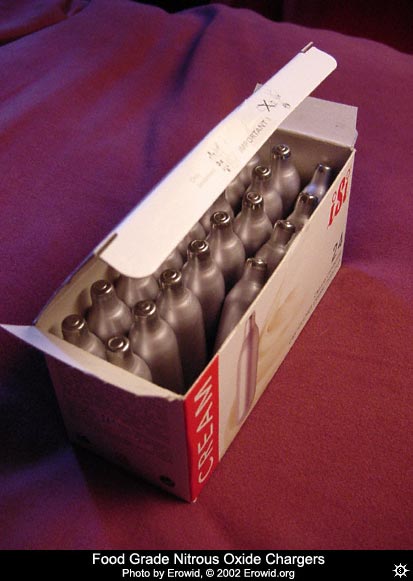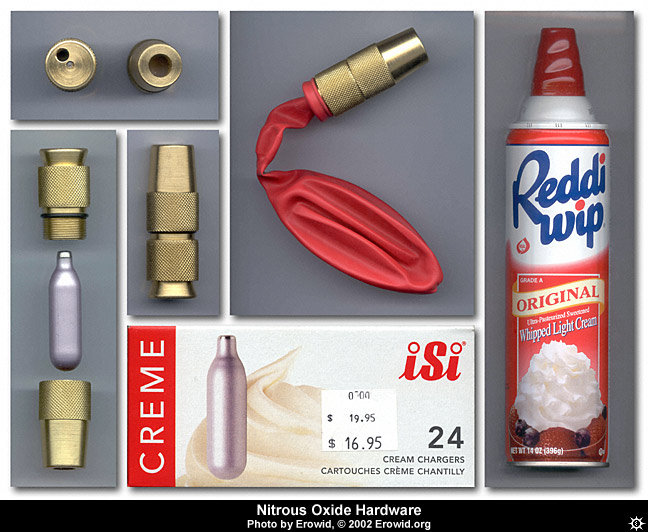Nitrous Oxide: Difference between revisions
GrimReaper (talk | contribs) |
GrimReaper (talk | contribs) |
||
| (7 intermediate revisions by 3 users not shown) | |||
| Line 1: | Line 1: | ||
[[File:Nitrous_package.jpg|right|200px]] | |||
Nitrous Oxide (N2O) is a simple gas that, when inhaled, causes rapid analgesia (pain relief), euphoria, mild sedation, and sometimes psychedelic dissociation. It is widely available and its effects are short lasting. | |||
== History == | |||
Nitrous Oxide was first discovered by English scientist Joseph Priestley in 1772, and was first published about in 1776. In 1799, Humphry Davy gave Nitrous Oxide to visitors of the Pneumatic Institute, and coined the term "laughing gas". Through his experiments, he discovered Nitrous Oxide's analgesic effects in 1800. From 1800 to 1840, Nitrous was primarily used for recreation at travelling public shows, but in 1844-1845 Nitrous was recognized as having some medical use in dentistry. In the late 1800's, William James published some accounts of his work with Nitrous Oxide, and called its effects of "some metaphysical significance". Nitrous has remained popular throughout the 20th century, and is sold over the counter in small cartridges ("whippets") for making whipped cream, and in large tanks for industrial and medical purposes. | |||
== Dosage == | |||
Nitrous is most frequently used in the form of whipped cream chargers, small metal cartridges which are 'cracked' either into a whipped cream canister or with a special 'cracker' into a balloon for inhalation. A single cartridge is between one and three lungs full of gas. One or two lung fulls is generally enough for a short nitrous experience although many people choose to use many cartridges throughout the course of a night. | |||
== Duration == | |||
=== Inhaled === | |||
Note: both the onset and duration increase with the dose. | |||
{| class="wikitable" | |||
|+ Inhaled | |||
|- | |||
| Onset || 0-1 minute | |||
|- | |||
| Total || 1-5 minutes | |||
|- | |||
| After-effects || 15-30 minutes | |||
|} | |||
== Effects == | |||
=== Postive === | |||
* Anxiolytic | |||
* Euphoria | |||
* Giggling and laughing | |||
* Neuroprotection | |||
* Dream-like state | |||
=== Neutral === | |||
* Analgesia | |||
* Sound distortion | |||
* Minor to strong hallucinations & visualizations | |||
=== Negative === | |||
* Neurotoxicity | |||
* Nausea | |||
* Headaches | |||
* Reduction of vitamin B12 levels in the body | |||
* Numbness in extremities | |||
== Harm Reduction == | |||
Nitrous Oxide should be mixed with air (50/50). If you got pure gas make sure you inhale air, so you don't suffocate yourself. | |||
* Make sure you are sitting down and won't hurt yourself if you get dizzy | |||
* Very cold temperatures of the gas can freeze the lips and throat if taken directly from a tank or whippit. Releasing the gas into a balloon first allows the gas to warm before being administered. | |||
* Avoid driving. | |||
* Avoid walking or moving in general if possible. | |||
=== Warning === | |||
* Nitric Oxide, a toxic industrial gas, is occasionally mistaken for Nitrous Oxide. Users should be careful they know what they are inhaling. Inhaling Nitric Oxide can permanently damage the lungs or kill. | |||
=== Potentiators === | |||
* Other [[:Category:Dissociative|Dissociatives]]. | |||
=== Interactions === | |||
Check out our [[Drug Combinations]] page and chart for interactions and combinations of Nitrous Oxide with other drugs. | |||
== Chemistry and Pharmacology == | |||
The mechanism of action of Nitrous Oxide can be found [https://en.wikipedia.org/wiki/Nitrous_oxide#Mechanism_of_action here]. | |||
== Images == | |||
[[File:Nitrous_collage.jpg|500px]] | |||
== Legal status== | |||
For a breakdown of the legal status of Nitrous Oxide click [https://www.erowid.org/chemicals/nitrous/nitrous_law.shtml here]. | |||
== Links == | |||
[https://en.wikipedia.org/wiki/Nitrous_oxide Wikipedia] | |||
[https://www.erowid.org/chemicals/nitrous/nitrous.shtml Erowid] | |||
[http://www.reddit.com/r/drugs/wiki/nitrous /r/Drugs Wiki] | |||
[[Category:Drugs]] | |||
[[Category:Dissociative]] | [[Category:Dissociative]] | ||
Latest revision as of 00:53, 11 March 2015

Nitrous Oxide (N2O) is a simple gas that, when inhaled, causes rapid analgesia (pain relief), euphoria, mild sedation, and sometimes psychedelic dissociation. It is widely available and its effects are short lasting.
History
Nitrous Oxide was first discovered by English scientist Joseph Priestley in 1772, and was first published about in 1776. In 1799, Humphry Davy gave Nitrous Oxide to visitors of the Pneumatic Institute, and coined the term "laughing gas". Through his experiments, he discovered Nitrous Oxide's analgesic effects in 1800. From 1800 to 1840, Nitrous was primarily used for recreation at travelling public shows, but in 1844-1845 Nitrous was recognized as having some medical use in dentistry. In the late 1800's, William James published some accounts of his work with Nitrous Oxide, and called its effects of "some metaphysical significance". Nitrous has remained popular throughout the 20th century, and is sold over the counter in small cartridges ("whippets") for making whipped cream, and in large tanks for industrial and medical purposes.
Dosage
Nitrous is most frequently used in the form of whipped cream chargers, small metal cartridges which are 'cracked' either into a whipped cream canister or with a special 'cracker' into a balloon for inhalation. A single cartridge is between one and three lungs full of gas. One or two lung fulls is generally enough for a short nitrous experience although many people choose to use many cartridges throughout the course of a night.
Duration
Inhaled
Note: both the onset and duration increase with the dose.
| Onset | 0-1 minute |
| Total | 1-5 minutes |
| After-effects | 15-30 minutes |
Effects
Postive
- Anxiolytic
- Euphoria
- Giggling and laughing
- Neuroprotection
- Dream-like state
Neutral
- Analgesia
- Sound distortion
- Minor to strong hallucinations & visualizations
Negative
- Neurotoxicity
- Nausea
- Headaches
- Reduction of vitamin B12 levels in the body
- Numbness in extremities
Harm Reduction
Nitrous Oxide should be mixed with air (50/50). If you got pure gas make sure you inhale air, so you don't suffocate yourself.
- Make sure you are sitting down and won't hurt yourself if you get dizzy
- Very cold temperatures of the gas can freeze the lips and throat if taken directly from a tank or whippit. Releasing the gas into a balloon first allows the gas to warm before being administered.
- Avoid driving.
- Avoid walking or moving in general if possible.
Warning
- Nitric Oxide, a toxic industrial gas, is occasionally mistaken for Nitrous Oxide. Users should be careful they know what they are inhaling. Inhaling Nitric Oxide can permanently damage the lungs or kill.
Potentiators
- Other Dissociatives.
Interactions
Check out our Drug Combinations page and chart for interactions and combinations of Nitrous Oxide with other drugs.
Chemistry and Pharmacology
The mechanism of action of Nitrous Oxide can be found here.
Images
Legal status
For a breakdown of the legal status of Nitrous Oxide click here.
